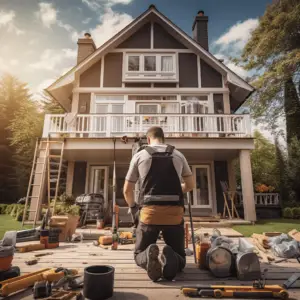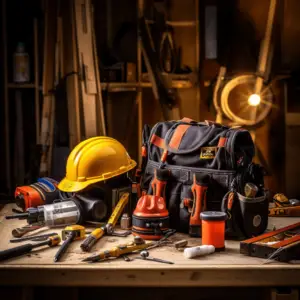Safety must be a priority when you start home maintenance projects. Wear protective gear such as gloves, goggles and strong shoes. This will help protect you from any harm that can happen when handling sharp tools or coming into contact with bad substances. Make sure the area is well ventilated, too.
Before beginning any task, look around to spot potential risks or obstacles. Check for loose floorboards or uneven surfaces that could cause you to trip.
Understand how to use the tools and equipment properly. Read instructions and learn the right way of using them. If you’re not sure, ask a professional or someone knowledgeable.
Here’s a true story that shows why safety is important. A few years ago, my neighbor Bob was doing repairs on his roof but didn’t take safety precautions. He slipped and fell, getting multiple fractures and needing a long recovery.
To stay safe and keep enjoying your home, stay informed, be ready and make the environment secure as you do your home maintenance projects.
Table of Contents
Necessary safety precautions before starting the project

Working on home maintenance projects can be fulfilling and cost-effective. But, safety should be prioritized! Necessary precautions must be taken before starting the project.
- Wear protective gear like goggles, gloves and helmets.
- Check for potential hazards like electrical wires or sharp objects.
- Use the right tools and make sure they are in good condition.
- Ventilate enclosed spaces to avoid inhaling hazardous chemicals or dust.
- Keep a first aid kit nearby and know basic first aid procedures.
Unique details must be considered for extra safety. For instance, be aware of physical limitations and ask for help if needed. Also, clear communication with anyone present in the vicinity is a must.
I learnt the importance of safety measures the hard way. Last summer, when I was renovating my kitchen, I didn’t wear appropriate protective gear and ended up getting several stitches due to a mistake with a sharp tool.
So, never forget that safety is of utmost importance for any home maintenance endeavor. By taking necessary precautions and being alert of potential risks, you can confidently work on your projects while keeping yourself safe.
Personal protective equipment (PPE)
Personal protective equipment (PPE) is vital for home maintenance projects. It helps prevent accidents and injuries. Here are some must-haves:
- Safety glasses – Protect eyes from flying debris or chemicals.
- Dust mask or respirator – Avoid inhaling harmful dust particles.
- Earplugs or earmuffs – Safeguard ears from loud noises.
- Gloves – Shield hands from sharp objects, chemicals, or extreme temperatures.
- Safety boots or shoes – Give foot protection against heavy objects and hazards.
Safety first! Invest in high-quality PPE that fits properly. Check for damage or wear and tear. Using the right PPE not only ensures safety but also boosts work efficiency and productivity. You can confidently focus on the task without distractions or fear of accidents.
To further enhance safety during home maintenance projects, follow these tips:
- Research potential hazards and identify the appropriate PPE.
- Choose protective gear suitable for the task and offering adequate coverage.
- Regularly inspect and clean your PPE. Replace items that are worn out.
- Stay updated with safety guidelines and receive training on how to use and maintain PPE.
Be proactive in using personal protective equipment. Adhere to these suggestions to minimize risks, protect yourself, and safely complete your home maintenance projects.
Understanding potential hazards and how to mitigate them
Want to know more about potential problems and how to prevent them? Take a look at this table:
| Hazard | Description | Mitigation Tips |
|---|---|---|
| Electrical | Risk of electrocution or shock when using wires or appliances | Turn off power. Wear insulated gloves and use insulated tools |
| Fire | Possibility of fire caused by faulty wiring or flammable materials | Install smoke detectors and fire extinguishers in key areas |
| Falling objects | Objects falling and causing injuries | Wear a hard hat and safety glasses. Secure heavy items |
| Chemical hazards | Exposure to toxic chemicals during painting or cleaning | Ensure ventilation. Gloves and safety glasses are a must |
This table gives great information. But, every project has its own special risks. Take time to research and get professional advice if needed.
Home Improvement Magazine did a study and found that homeowners who assess risks before starting projects have fewer accidents than those who don’t.
Understand potential hazards, take measures to prevent them, and ensure a safe work environment. Keep learning, stay alert, and above all, prioritize safety.
Safe handling of tools and equipment
When it comes to home maintenance, safety is key. Mishandling or misuse of tools and equipment can result in accidents and injuries. It’s essential to follow some guidelines to stay safe. Here’s a step-by-step guide:
- Pick the right tool for the job. Using the wrong one affects efficiency and is risky.
- Inspect tools before use. Look for any defects or damages that could compromise safety.
- Wear personal protective equipment (PPE) like gloves, goggles, helmets, or masks when using dangerous tools.
- Keep your workspace clean and organized. This prevents tripping over tools and materials.
- Read and follow manufacturer’s instructions. Learn how to use the tools properly, and the necessary safety precautions.
Here are some other key points to remember:
- Check power cords and make sure they’re in good condition.
- Keep cutting tools sharp. Dull blades require more force and can lead to mishaps.
- Use clamps or vice grips, instead of holding materials manually.
- Avoid distractions when using power tools.
- Store tools properly after use.
By following these tips and guidelines, you can ensure safety when working on home maintenance projects. The suggestions work to mitigate potential hazards by providing guidance on tool selection, inspection, PPE, workspace organization, instructions, and equipment maintenance. Safety practices are the key to a successful and safe DIY experience.
Steps to take in case of emergencies

In an emergency, act fast and efficiently to stay safe and limit damage. Here’s what to do:
- Assess the emergency: Figure out how severe it is. Is it a fire, electric shock, or injury? This will help you respond better.
- Call for help: Right away, call 911 or the local fire department. Give them your location and describe the emergency.
- Evacuate if needed: If necessary, leave the area quickly and calmly. Follow the evacuation route and don’t use elevators in case of a fire.
- Give basic first aid: If someone is hurt, do basic first aid until medical help arrives. Take care of wounds and apply pressure to stop bleeding.
- Inform others: Tell people nearby about the emergency and guide them to safety. Cooperation is important.
- Stay updated and follow instructions: Listen to authorities on-site and via news channels or social media.
When it comes to home maintenance projects, safety must come first. Pay attention to potential hazards, have safety gear nearby, and know the local emergency contact number. As a reminder of the seriousness of this, consider a story of an unfortunate event. A homeowner tried DIY electrical repairs without knowledge or training and caused a fire. This could have been avoided if they had asked for help from a professional. This shows the importance of knowing your limits and seeking expert advice in risky situations.
Conclusion: Recap of the importance of safety in home maintenance projects and final tips for staying safe.
Safety must always be a top priority when doing home maintenance. By following some essential tips, we can minimize accidents and ensure a safe working environment.
- Firstly, wear the right safety gear, e.g. goggles, gloves and hard hats. This shields the eyes, hands and head from potential dangers.
- Also, use power tools cautiously, ensuring they are in good condition and operated with the manufacturer’s instructions.
- Plus, keep the workspace clean and organised. Messy areas can cause tripping or falling, so storing tools and materials carefully can decrease the risk of accidents.
- Another factor to take into account is electrical safety. Before beginning electrical work, remember to switch off the power supply and use the right insulation for exposed wires. For more complex tasks, it is wise to hire a professional electrician.
- Moreover, inspect and maintain equipment and structures regularly. Check for any signs of wear or damage to prevent incidents caused by faulty equipment or structural issues.
- Finally, involve others in your projects for increased safety. Having someone nearby can give assistance in emergencies or accidents.
Frequently Asked Questions
1. How do I stay safe while working on home maintenance projects?
Always wear appropriate safety gear such as gloves, goggles, and a helmet when necessary. Follow safety guidelines, use proper tools, and work in a well-ventilated area. Avoid rushing the process and take breaks when needed to prevent fatigue and potential accidents.
2. What precautions should I take when working with power tools?
Ensure power tools are in good condition and properly maintained. Always unplug them when not in use and use grounded outlets. Keep cords away from sharp objects and liquids. When using power tools, maintain a firm grip, focus on the task at hand, and never leave them unattended.
3. How should I deal with hazardous materials during home maintenance projects?
Identify hazardous materials beforehand and handle them according to local regulations. Wear protective clothing, gloves, and masks when handling chemicals. Store hazardous substances in their original containers and dispose of them properly. Keep children and pets away from these materials at all times.
4. Are there any precautions to take while working at heights?
Ensure the use of proper safety equipment such as harnesses and ladders with built-in stabilizers. Inspect equipment for any defects before using them. Avoid working at heights alone and make sure there’s someone nearby who can assist you if needed. Be cautious of weather conditions, especially strong winds.
5. How can I prevent electrical accidents during home maintenance projects?
Turn off the power supply before working on any electrical components. Use insulated tools and gloves when dealing with electricity. Be aware of the location of electrical wires and avoid cutting or drilling into walls without proper knowledge. If uncertain about any electrical work, consult a professional electrician.
6. What should I do if an accident occurs while working on home maintenance projects?
First, assess the situation to determine the severity of the accident. For minor injuries, administer first aid if you have proper knowledge. For more serious injuries, seek immediate medical attention. Always keep emergency contact numbers readily available in case of accidents or emergencies.